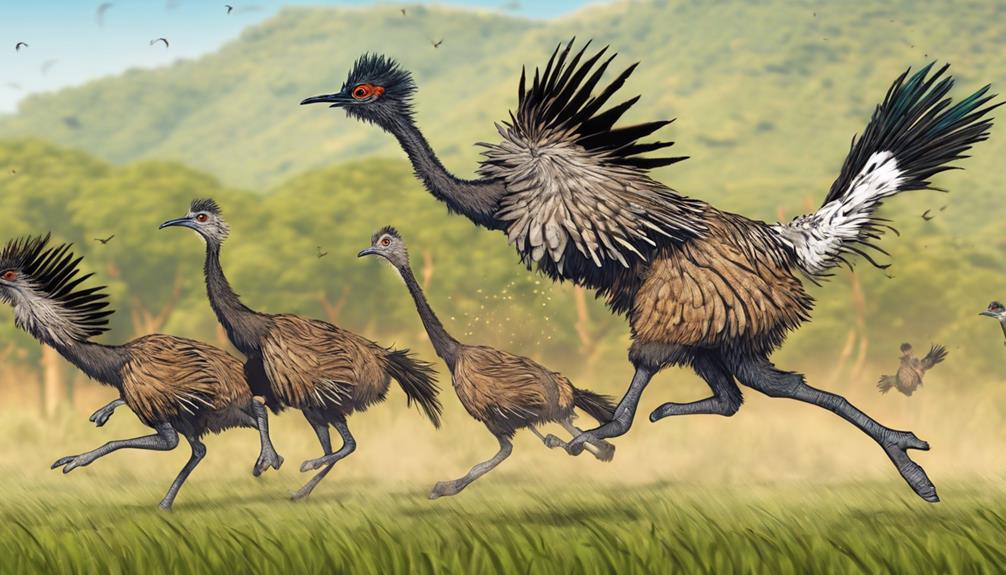Have you ever imagined witnessing a race where the competitors are not humans, but birds that move with astonishing speed?
As you explore the domain of 'Birds That Run FAST,' you'll encounter a diverse cast of avian athletes known for their remarkable running abilities.
From the graceful Ostrich to the colorful Takahe, each bird on the list of Top 10 Running Birds brings a fascinating story of speed and adaptation.
Discover the secrets behind their swift movements and the intriguing characteristics that make them stand out in the avian world.
Ostrich – The Fastest Running Bird
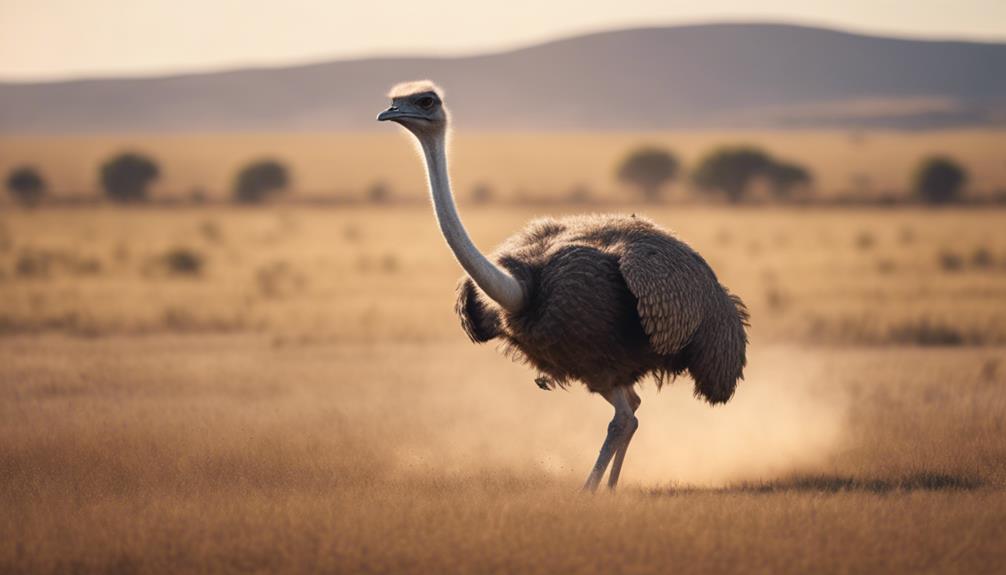
When it comes to speed in the avian world, the Ostrich outruns them all as the fastest running bird. With powerful legs capable of covering long distances at incredible speeds, the Ostrich can reach up to 45 miles per hour, making it a true speed champion among birds. This remarkable ability allows the Ostrich to investigate predators and navigate its vast habitats efficiently.
Unlike other birds that rely on flight for survival, the Ostrich's adaptation for ground speed is truly impressive. Their strong, muscular legs propel them forward with remarkable agility, showcasing nature's incredible evolutionary designs. Observing these majestic creatures in full sprint is a sight to behold, highlighting their grace and power in motion.
As you explore the world of avian speedsters, the Ostrich stands out as a prime example of nature's exceptional athleticism. Appreciating the Ostrich's unmatched running capabilities sheds light on the diverse and fascinating adaptations found in the animal kingdom.
Rhea – Speedy Runner in Groups
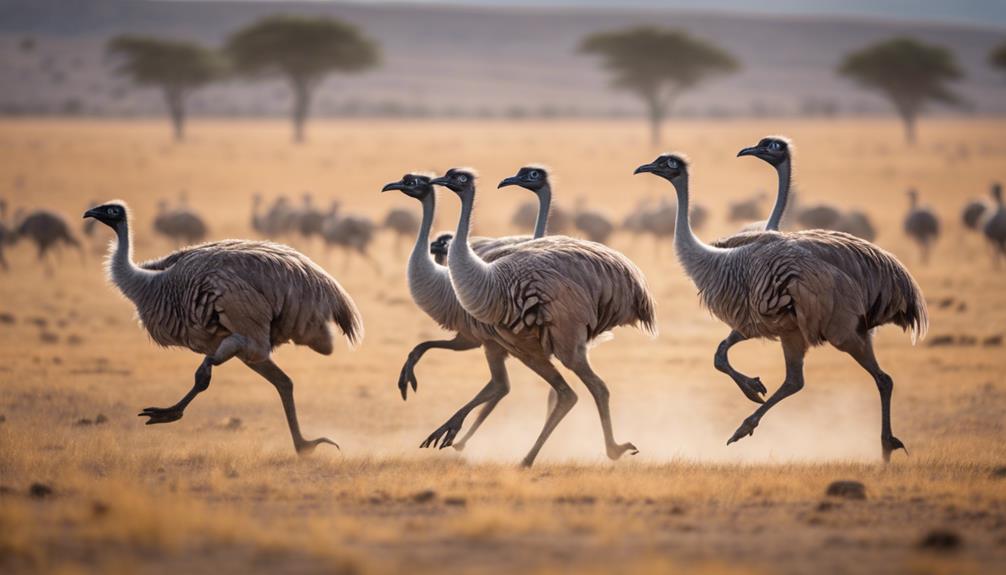
With their swift running abilities and preference for group living, Rheas showcase remarkable speed and social behavior among running birds. These flightless birds, native to South America, are known for their agility and the ability to reach speeds of up to 35 mph. Rheas typically live in flocks, which provide them with safety in numbers against predators. Their group dynamics involve a dominant male that takes charge of protecting the group and its territory.
Rheas' group behavior extends to their breeding habits, where multiple females lay eggs in a communal nest for the male to incubate and care for. This cooperative breeding system enhances their social bonds and increases the chances of survival for their offspring. Additionally, living in groups allows Rheas to communicate effectively through various vocalizations, ensuring coordinated movement and alerting others to potential dangers.
Chicken – Flightless Speed Demon
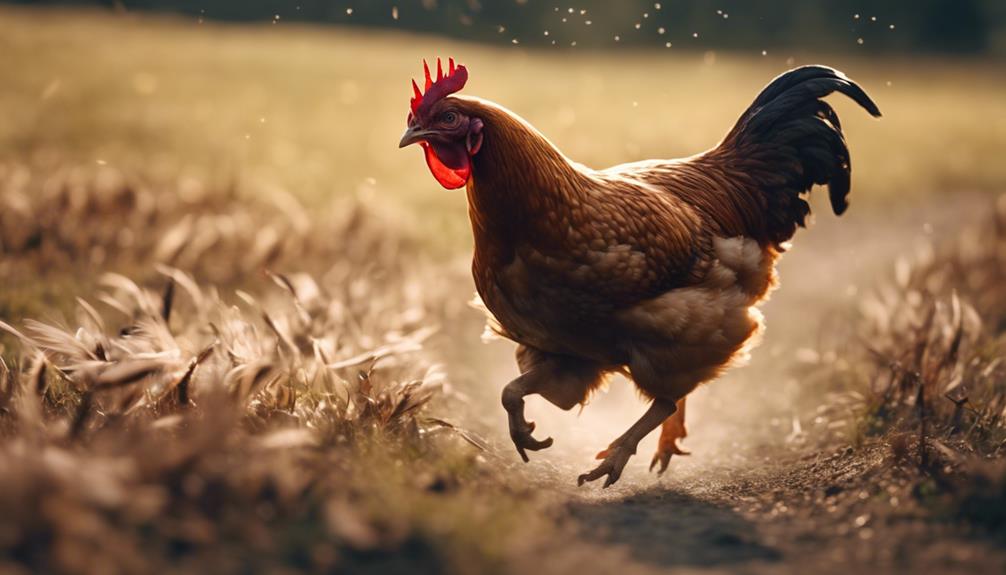
Despite its inability to fly, the Chicken is a remarkable speed demon on the ground, showcasing impressive running capabilities. With a top speed of 9 mph, chickens may not soar through the skies, but they sure can zip around on land. These flightless birds have strong, muscular legs that propel them forward with surprising agility. Whether they're foraging for food or evading predators, chickens rely on their rapid running abilities to survive in their environments.
Chickens' knack for speed isn't just about running; they also exhibit quick reflexes and can change direction swiftly when needed. This agility comes in handy when maneuvering their surroundings and avoiding potential dangers. Despite their domestication for centuries, chickens have retained their natural instinct for speed and agility, making them fascinating creatures to observe in action.
Weka Bird – New Zealand Sprinter
The Weka Bird, native to New Zealand, is renowned for its swift sprinting abilities in its natural habitat. This bird, with its brown plumage and distinctive red beak, is a proficient runner, reaching speeds of up to 28 miles per hour. Wekas have strong legs that enable them to navigate various terrains with agility, making them adept at evading predators and hunting for food.
These ground-dwelling birds are known for their curious and bold nature, often approaching humans in search of food. Wekas have a reputation for being resourceful and opportunistic, with a knack for stealing shiny objects or unattended snacks. Their adaptability to different environments, from forests to coastal regions, showcases their versatility as runners and survivors.
In New Zealand, conservation efforts are crucial to protect the Weka Bird's population, as they face threats from habitat loss and introduced predators. By raising awareness about these sprinters and supporting conservation initiatives, we can help guarantee the continued existence of this unique and spirited bird species.
Tinamou Bird – Ground Speedster
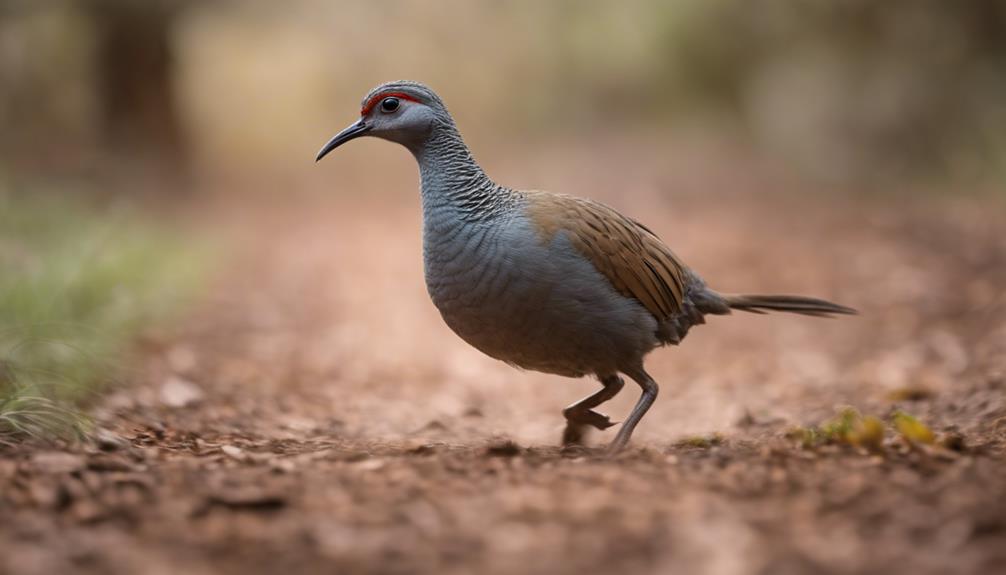
How does the Tinamou Bird showcase its exceptional ground speed capabilities?
The Tinamou Bird, despite not being a well-known runner like the Ostrich or Emu, is a ground speedster worth mentioning. Found in Central and South America, this bird may not fly much, but it makes up for it with its impressive running skills.
The Tinamou Bird can reach speeds of up to 20 miles per hour, making it a swift runner in its habitat. Its strong legs and streamlined body allow it to navigate through dense vegetation and evade predators effectively.
Unlike the larger flightless birds, the Tinamou Bird's smaller size enables it to maneuver swiftly in its environment.
Cassowary – Dangerous Sprinter
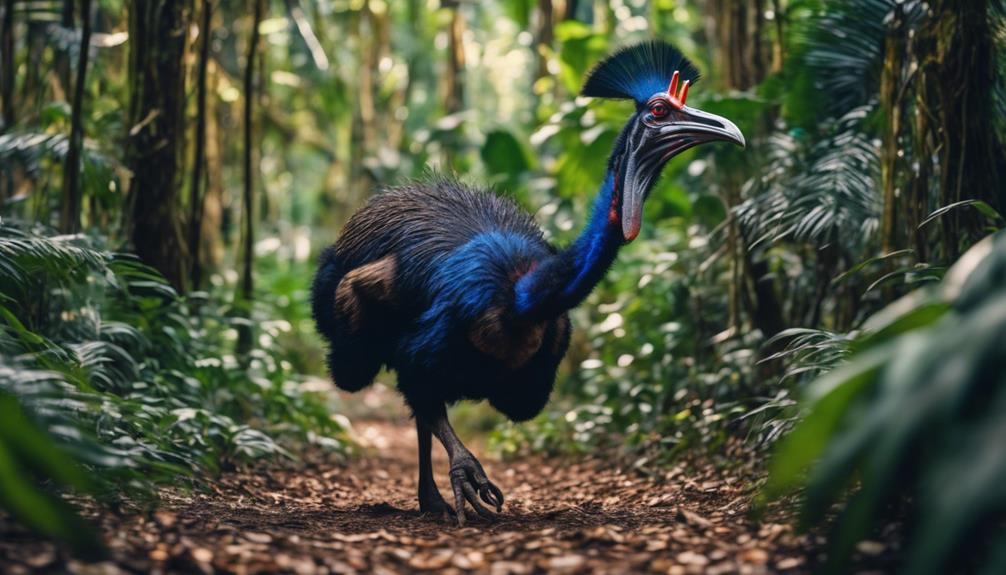
Keep a safe distance when encountering the Cassowary, known for its vital sprinting abilities in the wild. These large flightless birds from Australia and surrounding islands can reach speeds of up to 30 miles per hour, making them one of the fastest running birds.
The Cassowary's sharp claws, powerful legs, and aggressive nature contribute to its reputation as a formidable sprinter. In addition to their speed, Cassowaries are known for their territorial behavior, which can lead to aggressive encounters if they feel threatened. It's important to respect their space and observe them from a safe distance to avoid any potential confrontations.
Conservation efforts are essential to protect these unique birds and their habitats, ensuring their survival in the face of various threats. By understanding and appreciating the Cassowary's impressive sprinting capabilities, we can better appreciate the importance of preserving these remarkable creatures in the wild.
Road Runner – Iconic Fast Bird
Encountering the Cassowary's deadly sprinting abilities highlights the remarkable speed and unique characteristics of the Road Runner, an iconic fast bird known for its distinctive features and rapid movements.
With its slender body, unique head crest, and long legs, the Road Runner is a fascinating bird to observe in action. This bird, famous for its appearance in cartoons, can reach speeds of up to 20 miles per hour when darting across the desert landscape.
The Road Runner's agile movements and quick reflexes make it a mesmerizing subject for bird enthusiasts and researchers alike. Its ability to outmaneuver predators and swiftly navigate its environment showcases its evolutionary adaptations for speed and survival.
If you ever catch a glimpse of a Road Runner in the wild, you'll be amazed by its swift and graceful running prowess, demonstrating why it truly deserves its reputation as one of the fastest birds on land.
Guam Rail – Quick and Agile
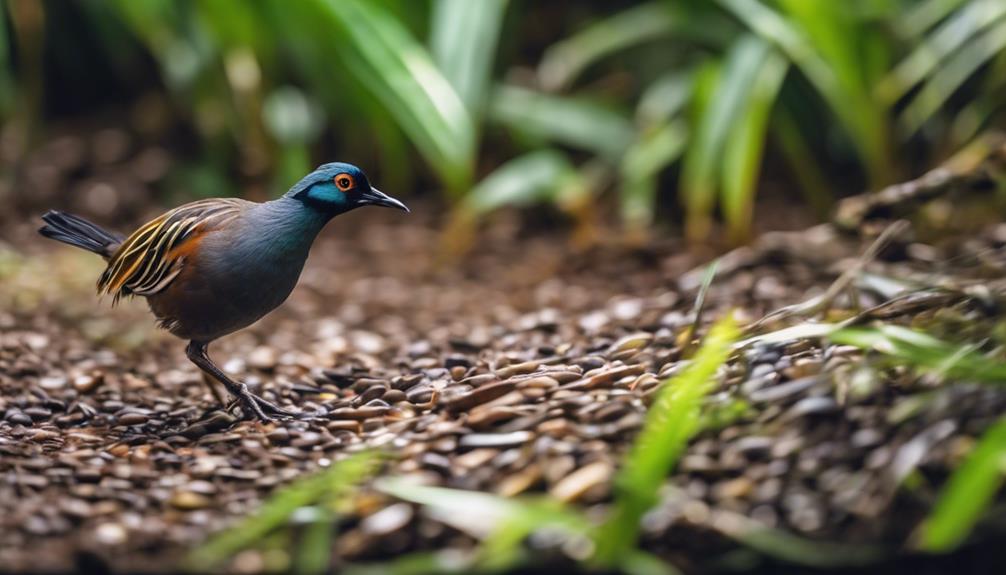
The Guam Rail impresses with its quick and agile movements in its natural habitat. This bird, endemic to the island of Guam, displays remarkable speed and agility as it navigates through the dense vegetation of the forests. With its small, compressed body, the Guam Rail can swiftly dart between trees and undergrowth, making it a challenge to spot despite its distinctive screeching call. When faced with threats or loud noises, the Guam Rail showcases its agility by swiftly evading danger and seeking cover in the foliage.
This bird's ability to move rapidly and adeptly in its environment not only aids in its survival but also demonstrates its remarkable adaptation to the challenges of its habitat. Observing the Guam Rail in action provides insight into the agility and quick reflexes necessary for its existence in the wild. Through conservation efforts and awareness of its unique characteristics, the Guam Rail's impressive speed and agility can continue to captivate and inspire bird enthusiasts and conservationists alike.
Takahe – Colorful Speedster
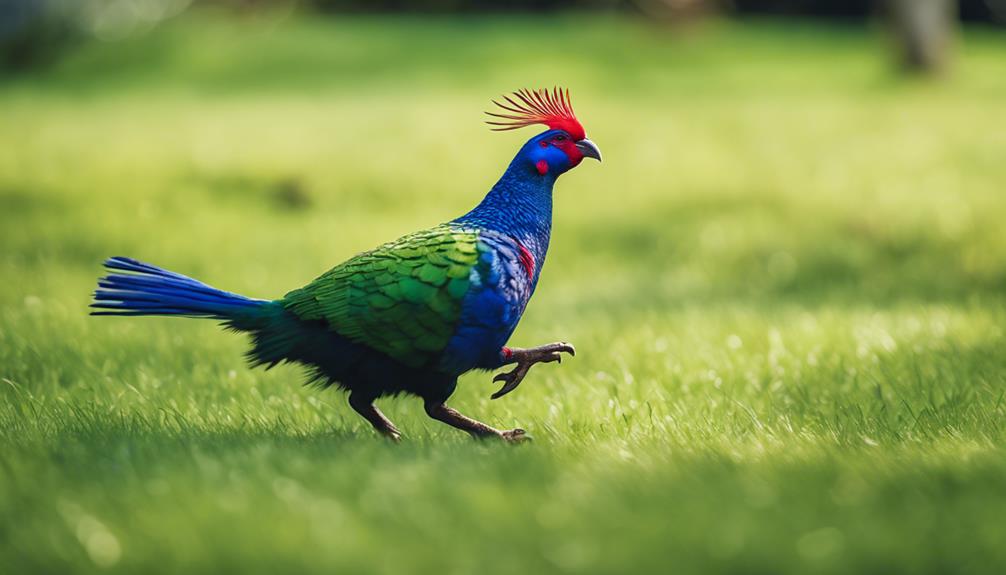
Colorful and spirited, the Takahe stands out as a vibrant speedster among its avian counterparts. With its striking green-blue feathers and a vivid red bill, this bird not only catches the eye but also boasts impressive running capabilities. The Takahe is known for its agility and speed, reaching up to 9 miles per hour when on the move. Despite its colorful appearance, this bird is a serious contender in the race of fast runners.
Native to New Zealand, the Takahe thrives in alpine grasslands and tussock wetlands. Its endurance and adaptability make it a remarkable species well-suited for its environment. The Takahe's longevity, with a lifespan of around 20 years, allows it to continue gracing the landscape with its vivid hues and swift movements.
Appreciating the Takahe's vibrant colors and swift pace not only adds to the beauty of nature but also highlights the importance of conservation efforts to safeguard the survival of this colorful speedster.
Emu – Second-Largest Running Bird
Appreciating the Takahe's vibrant colors and swift pace, let's now explore the Emu, the second-largest running bird, known for its impressive size and speed. Emus, native to Australia's forests and sand plains, are flightless birds that can reach up to 6.2 feet in height and weigh around 100 pounds. These magnificent creatures are exceptional runners, capable of sprinting at speeds of up to 30 miles per hour, making them one of the fastest birds on land.
Emus have long, powerful legs that allow them to cover great distances with remarkable agility. Their strong muscles and unique joint structure enable them to take long strides while maintaining balance and speed. These birds exhibit a fascinating combination of strength and swiftness, making them well-adapted for their natural habitat.
In addition to their impressive running abilities, Emus play an important role in their ecosystem by dispersing seeds and shaping vegetation through their foraging habits. As with many fast-running birds, conservation efforts are important to ensuring the preservation of these magnificent creatures for future generations.

Erzsebet Frey (Eli Frey) is an ecologist and online entrepreneur with a Master of Science in Ecology from the University of Belgrade. Originally from Serbia, she has lived in Sri Lanka since 2017. Eli has worked internationally in countries like Oman, Brazil, Germany, and Sri Lanka. In 2018, she expanded into SEO and blogging, completing courses from UC Davis and Edinburgh. Eli has founded multiple websites focused on biology, ecology, environmental science, sustainable and simple living, and outdoor activities. She enjoys creating nature and simple living videos on YouTube and participates in speleology, diving, and hiking.
🌿 Explore the Wild Side!
Discover eBooks, guides, templates and stylish wildlife-themed T-shirts, notebooks, scrunchies, bandanas, and tote bags. Perfect for nature lovers and wildlife enthusiasts!
Visit My Shop →
